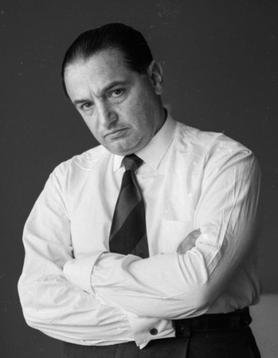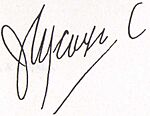Jorge Icaza Coronel facts for kids
Quick facts for kids
Jorge Icaza Coronel
|
|
|---|---|
 |
|
| Born | July 10, 1906 Quito, Ecuador |
| Died | May 26, 1978 (aged 71) Quito, Ecuador |
| Pen name | Jorge Icaza |
| Occupation | Writer |
| Genre | Social Realism |
| Notable works | Huasipungo (1934), El chulla Romero y Flores (1958) |
| Spouse | Marina Moncayo |
| Children | Fenia Cristina Icaza Moncayo |
| Signature | |
 |
|
Jorge Icaza Coronel (born July 10, 1906 – died May 26, 1978) was a famous writer from Ecuador. He is best known for his book Huasipungo. This novel helped show the world how native people in Ecuador were treated unfairly. Jorge Icaza was born and died in Quito, Ecuador.
Contents
Jorge Icaza's Writing Journey
Starting as a Playwright
Jorge Icaza began his writing career by writing plays. Some of his early plays include El Intruso (1928) and La Comedia sin Nombre (1929). He also wrote Cuál es (1931), Sin Sentido (1932), and Flagelo (1936).
In 1933, his play El Dictador was not allowed to be shown. After this, Icaza decided to write novels instead. He wanted to focus on the difficult lives of people in Ecuador. He especially wanted to show the unfair treatment of native people.
Becoming a Famous Novelist
Jorge Icaza became very famous when he published his novel Huasipungo in 1934. This book became a key part of the "Indigenist" movement. This movement in Latin American literature aimed to show the real struggles of indigenous people.
Parts of Huasipungo were first translated into English in Russia. People there, especially farmers, really liked the book. Later, Jorge Icaza became Ecuador's ambassador to Russia.
The first full English version of Huasipungo came out in 1962. It was translated by Mervyn Savill. Another official translation, called "The Villagers," was published in 1964.
Icaza wrote other important books too. These include Sierra (1933), En las calles (1936), and Cholos (1938). He also wrote Media vida deslumbrados (1942) and Huayrapamushcas (1948).
Two of his later novels, El chulla Romero y Flores (1958) and Atrapados (1973), are considered his best by experts. However, Huasipungo remains his most popular work. It has been translated into more than 40 languages around the world.
Impact of His Work
Jorge Icaza and his book Huasipungo are often compared to John Steinbeck and his novel The Grapes of Wrath. Both books are powerful stories that protest against social problems. Huasipungo was rewritten several times in Spanish to make it easier to read.
Besides being an "Indigenist" novel, Huasipungo is also seen as a "proletarian novel." This means it focuses on the lives of working-class people. In Latin America, native people often represented this working class in literature.
Because of his popular books, Icaza became known worldwide. He was invited to many colleges in the United States. There, he gave talks about the challenges faced by the native people of Ecuador.
List of Works
| Year of Publication | Literary work | Genre |
|---|---|---|
| 1931 | ¿Cuál es? y Como ellos quieren | Theatre |
| 1931 | Sin sentido | Theatre |
| 1933 | Barro de la sierra | Short Stories |
| 1934 | Huasipungo | Novel |
| 1935 | En las calles | Novel |
| 1936 | Flagelo | Theatre |
| 1937 | Cholos | Novel |
| 1942 | Media vida deslumbrados | Novel |
| 1948 | Huairapamushcas | Novel |
| 1958 | El chulla Romero y Flores | Novel |
| 1961 | Obras escogidas | |
| 1969 | Relatos | Short stories |
| 1972 | Atrapados | Novel |
See also
 In Spanish: Jorge Icaza para niños
In Spanish: Jorge Icaza para niños

